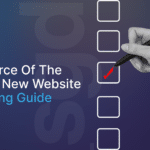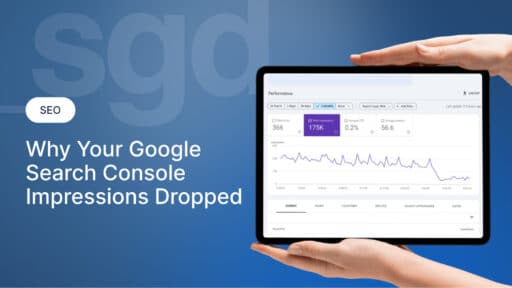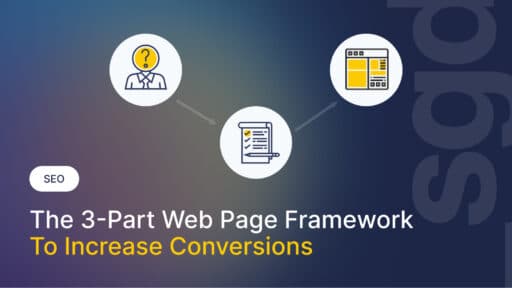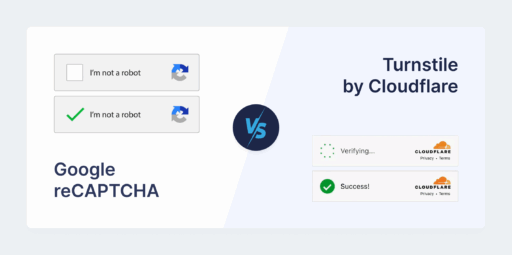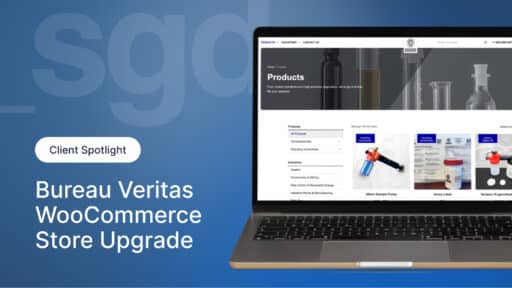How To Write A Website Project Brief (Template Included)
April 7, 2025 — Simon Kelly

Planning a new website design project? Success starts with a clear strategy and project brief before you begin.
A strong web design project brief is one of the most underrated (but essential) tools for a smooth, successful website build.
Without a clear brief, even the best web design agency will struggle to deliver exactly what you need.
This can result in misaligned expectations, wasted time, blown budgets, and frustration for everyone involved…
The good news is that creating a great website project brief isn’t hard.
You don’t need to know technical jargon — you just need to clearly articulate your goals, audience, and key requirements.
And if you’ve never written a web brief before, that’s completely okay. In fact, most of our clients haven’t before they start working with us. You just need to know the key things to communicate — and that’s exactly what we’ll walk you through below.
At SGD, we’ve seen firsthand how much smoother, faster, and more effective website projects are when clients invest time upfront to create a solid project brief.
With the step-by-step guide below, we’ll show you how to create a brief that clearly communicates your goals, needs, and style.
Whether you’ve selected an agency or not, completing this will ensure you start your project on the right foot.
Here’s exactly what to include in your web design project brief, as well as a simple template you can download and use on your next project.
Step 1: Introduce Your Business
Before you talk about the website, help your agency understand your business and where it sits in your industry. Cover:
- What you do and who you do it for
- Your products or services
- The markets or industries you work with
- Your brand positioning and values
- What makes you different from competitors
SGD Tip: Avoid assuming your agency already understands your industry. Even basic background helps your web team tailor a site that speaks directly to your audience.
Step 2: Outline the Project Goals
What does success look like? What should this project achieve? Typical project goals include:
- Generate more qualified enquiries
- Sell more products online
- Build trust and credibility
- Support existing clients
- Promote a new service or offering
SGD Advice: Link your goals to specific, measurable business outcomes— not just vague statements like “we want a better website.” For example, “We want to increase qualified leads by 30% within six months” is much more useful for your agency and for measuring success later. Try and think about your goals in the following categories:
- How does it need to look? (e.g. new branding? Or the same?)
- What outcome do I want to achieve? (e.g. more traffic/sales)
- What functions does it need to facilitate? (e.g. online booking)
Step 3: Define Your Target Audience
Your website is for your clients, not for you. The clearer you can be about who they are and what they need, the better your website will perform. Include:
- Who your ideal clients are (age, location, industry, demographics)
- Their common pain points or problems
- What they value when choosing a business like yours
- Where they typically sit in the buying journey when visiting your site
SGD Insight: If you don’t have formal customer personas, that’s okay. Even a few sentences about your typical clients, their challenges, and what matters most to them will help your agency design a user-friendly site.
Step 4: List Your Must-Haves and Nice-to-Haves
This is where you shape the scope of your project. Think of it as your website wish list, but divided into two categories.
Must-Haves (essential for launch):
- Mobile-friendly design
- Core pages (Home, About, Services, Contact)
- Conversion points (contact forms, booking systems, CTAs)
- Speed optimisation
- Basic SEO foundations
Nice-to-Haves (optional for launch, ideal for future updates):
- Blog or news section
- Live chat
- Client portal
- Advanced SEO and content marketing
- Custom integrations (CRMs, booking systems, calculators)
SGD Advice: Be realistic about what you actually need on day one. You can always add features later, and prioritising now will help keep your project on time and on budget.
Step 5: Explain Your Style and Design Preferences
Design is subjective. A clear understanding of your taste will help avoid rounds of unnecessary revisions. Provide:
- Your brand guidelines (logo, colours, fonts)
- Links to websites you like (and why you like them)
- Links to websites you don’t like (and why)
- Any brand rules or non-negotiables
SGD Tip: You don’t need to supply perfect design references. Just help us understand the feeling you want visitors to have when they land on your site— professional, fun, high-end, bold, minimalist, or anything in between.
Step 6: Define the Project Scope and Deliverables
This is where you outline exactly what is (and isn’t) included in the project. Remember, a great agency will help you define this, but knowing these details can help you have a clear vision on scope before the conversation happens. Cover:
- How many pages do you need (or an estimate!)
- Who is supplying content (you, SGD, or both)
- Whether you need professional photography or stock images
- Any integrations you require (booking systems, payment gateways, CRMs)
- Any technical requirements (platform preferences like WordPress, Shopify, custom-built, etc.)
SGD Insight: Content is often underestimated. If you need help writing or gathering content, let your agency know upfront. It’s one of the biggest causes of project delays.
Step 7: Budget and Timeline
It’s completely normal to have a budget range rather than a fixed figure, but giving your agency a ballpark helps everyone stay on the same page. Not sure or don’t have a timeline? Your agency may also guide you here. Include:
- Budget range (including whether you need help with SEO, content writing, or ongoing maintenance)
- Ideal launch date
- Any hard deadlines (seasonal campaigns, events, product launches)
SGD Advice: Build in buffer time. Many projects take longer than expected, often because of content delays or internal review cycles.
Step 8: Introduce Your Internal Team
Help your agency understand who they will be working with. Identify:
- Who is leading the project internally
- Who is responsible for content
- Who will be giving feedback and approvals
SGD Insight: The best projects have one main decision-maker. Design by committee often leads to delays, extra costs, and watered-down results.
Your Checklist: What to Provide Your Web Design Agency at Kick-off
Here’s a simple checklist of what’s helpful to share:
- A completed web design project brief
- Your existing brand guidelines, logos, and assets
- Access to your current website (if applicable)
- Customer personas (if available)
- Examples of competitor sites you like or dislike (and what specifically you like or dislike about each)
- Any existing SEO research or marketing collateral
Download The Website Project Brief Template
To give you a shortcut to create a website project brief, we’ve created a simple template you can download and use immediately.
In the template, you’ll find:
- The exact sections we recommend to every client
- Helpful prompts so you don’t miss critical details
- A checklist to keep your project smooth from day one
Whether you’ve chosen a web design agency or not, having this brief ready will help you get clearer on what you want — and help your agency deliver it.
Download the project brief template
Click the link then go to File > Make a copy so you can edit to suit your project.
The Bottom Line: Always Use A Project Brief
A strong web design brief helps you get the best from your agency — better results, faster timelines, and fewer headaches.
At SGD, we love it when clients come prepared, but we also love helping businesses figure it out if they don’t know where to start.
Whether you have a fully formed project brief or just a few ideas on a page, we’ll help you shape it into a plan that gets results.
Want expert input on your website strategy or brief? Tell us about your project, and let’s map out your next steps.
Author

Simon Kelly
Simon Kelly is the CEO and Head of Growth at SGD. Simon started his first web agency in 2009 which he merged with the SGD team in 2023. With a strong background in digital strategy and a history of working with fast-growing Australian companies, including CyberCX, Envato and Agency Mavericks, he's passionate about using ethical digital marketing that delivers business value. Simon's experience includes coaching digital agencies, running digital marketing workshops, driving growth and excellence within the SGD team.
Unlock Weekly Insights To Improve Your Website
Want to improve your website and digital marketing? Sign up to Marketing Monday for practical, up-to-date strategies on SEO, Google Ads, and website performance—delivered weekly.
No fluff, just results-driven advice. Unsubscribe anytime.
Next Article
Resource of the Week: New Website Planning Guide
April 5, 2025Start a Project


